6.5 Memory Failures: The Seven Sins of Memory
You probably haven’t given much thought to breathing today, and the reason is that from the moment you woke up, you’ve been doing it effortlessly and well. But the moment breathing fails, you are reminded of just how important it is. Memory is like that. Every time we see, think, notice, imagine, or wonder, we are drawing on our ability to use information stored in our brains, but it isn’t until this ability fails that we become acutely aware of just how much we should treasure it. Such memory errors—
1. Transience
On March 6, 2007, I. Lewis “Scooter” Libby, former Chief of Staff to Vice President Dick Cheney, was convicted of perjury during an FBI investigation into whether members of the Bush administration had unlawfully disclosed the identity of a CIA agent to the media. According to Libby’s defense team, any misstatements he might have made in response to FBI questioning were the result of faulty memory, not an intention to deceive. How could Libby forget such important events? Research has shown that memories can and do degrade with time. The culprit here is transience, forgetting what occurs with the passage of time.
transience
Forgetting what occurs with the passage of time.
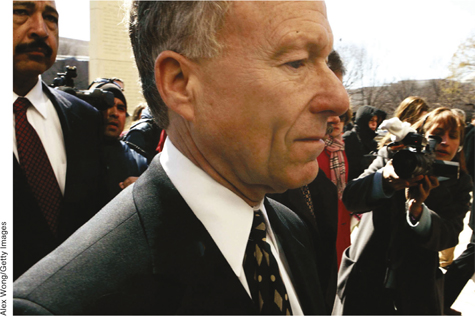
Transience occurs during the storage phase of memory after an experience has been encoded and before it is retrieved. This was first illustrated in the late 1870s by Hermann Ebbinghaus, a German philosopher who measured his own memory for lists of nonsense syllables at different delays after studying them (Ebbinghaus, 1885/1964). Ebbinghaus charted his recall of nonsense syllables over time, creating the forgetting curve shown in FIGURE 6.15. Ebbinghaus noted a rapid drop-
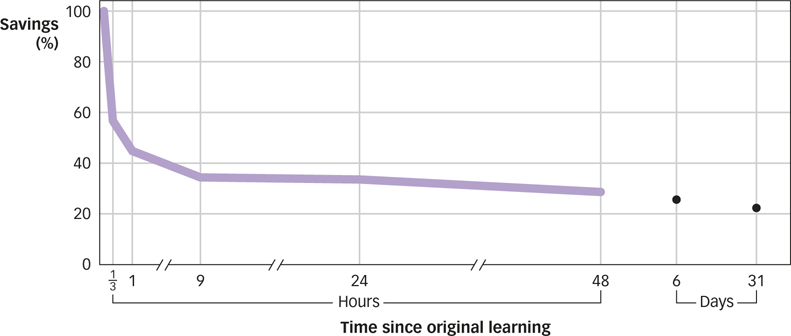
194
When does forgetting occur most rapidly?
Another way that memories can be distorted is by interference from other memories. For example, if you carry out the same activities at work each day, by the time Friday rolls around, it may be difficult to remember what you did on Monday because later activities blend in with earlier ones. This is an example of retroactive interference, situations in which later learning impairs memory for information acquired earlier (Postman & Underwood, 1973). Proactive interference, in contrast, refers to situations in which earlier learning impairs memory for information acquired later. If you use the same parking lot each day at work or at school, you’ve probably gone out to find your car and then stood there confused by the memories of having parked it on previous days.
retroactive interference
Situations in which later learning impairs memory for information acquired earlier.
proactive interference
Situations in which earlier learning impairs memory for information acquired later.
2. Absentmindedness
The great cellist Yo-
absentmindedness
A lapse in attention that results in memory failure.
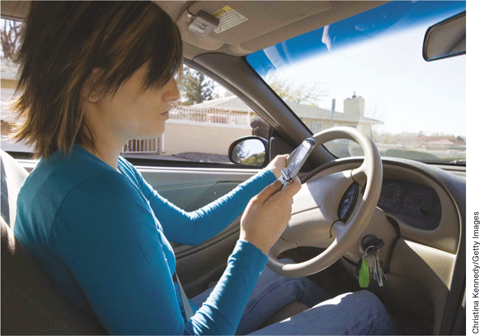
What makes people absentminded? One common cause is lack of attention. Attention plays a vital role in encoding information into long-
195
What happens in the brain when attention is divided? As you saw earlier, greater activity in the lower left frontal region during encoding is associated with better memory. But participants showed less activity in the lower left frontal lobe when their attention was divided (Shallice et al., 1994). Dividing attention, then, prevents the lower left frontal lobe from playing its normal role in semantic encoding, and the result is absentminded forgetting. Divided attention also leads to less hippocampal involvement in encoding (Kensinger, Clarke, & Corkin, 2003; Uncapher & Rugg, 2008). Given the importance of the hippocampus to episodic memory, this finding may help to explain why absentminded forgetting is sometimes so extreme, as when we forget where we put our keys or glasses only moments earlier.
How is memory affected for someone whose attention is divided?
Another common cause of absentmindedness is forgetting to carry out actions that we planned to do in the future. On any given day, you need to remember the times and places that your classes meet, you need to remember with whom and where you are having lunch, and so on; this is called prospective memory, remembering to do things in the future (Einstein & McDaniel, 1990, 2005).
prospective memory
Remembering to do things in the future.
3. Blocking
Have you ever tried to recall the name of a famous movie actor or a book you’ve read—
blocking
A failure to retrieve information that is available in memory even though you are trying to produce it.

Blocking occurs especially often for the names of people and places (Cohen, 1990; Semenza, 2009; Valentine, Brennen, & Brédart, 1996). Why? Because their links to related concepts and knowledge are weaker than for common names. That somebody’s last name is Baker doesn’t tell us much about the person, but saying that he is a baker does. To illustrate this point, researchers showed people pictures of cartoon and comic strip characters, some with descriptive names that highlight key features of the character (e.g., Grumpy, Snow White, Scrooge) and others with arbitrary names (e.g., Aladdin, Mary Poppins, Pinocchio; Brédart & Valentine, 1998). Even though the two types of names were equally familiar to participants in the experiment, they blocked less often on the descriptive names than on the arbitrary names.
Why is Snow White’s name easier to remember than Mary Poppins’ name?
Although it’s frustrating when it occurs, blocking is a relatively infrequent event for most of us. However, it occurs more often as we grow older, and it is a very common complaint among people in their 60s and 70s (Burke et al., 1991; Schwartz, 2002). Even more striking, some individuals with brain damage live in a nearly perpetual tip-
196
4. Memory Misattribution
Shortly after the 1995 bombing of the federal building in Oklahoma City, police set about searching for two suspects they called John Doe 1 and John Doe 2. John Doe 1 turned out to be Timothy McVeigh, who was quickly apprehended and later convicted of the crime and sentenced to death. John Doe 2, who had supposedly accompanied McVeigh when he rented a van two days before the bombing, was never found. In fact, John Doe 2 had never existed; he was a product of the memory of Tom Kessinger, a mechanic who was present when McVeigh rented the van. The day after, two other men had also rented a van in Kessinger’s presence. The first man, like McVeigh, was tall and fair. The second man was shorter and stockier, was dark-
memory misattribution
Assigning a recollection or an idea to the wrong source.
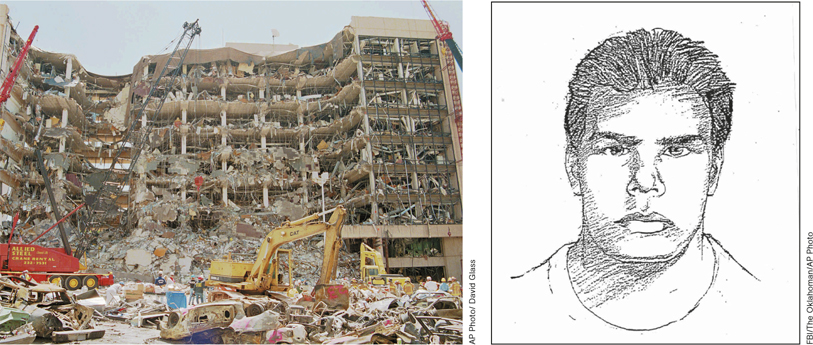
FBI/The Oklahoman/AP Photo
What can explain a déjà vu experience?
Part of memory is knowing where our memories came from. This is known as source memory, recall of when, where, and how information was acquired (Johnson, Hashtroudi, & Lindsay, 1993; Mitchell & Johnson, 2009; Schacter, Harbluk, & McLachlan, 1984). People sometimes correctly recall a fact they learned earlier or accurately recognize a person or object they have seen before but misattribute the source of this knowledge—
source memory
Recall of when, where, and how information was acquired.
197
|
Sour |
Thread |
|
Candy |
Pin |
|
Sugar |
Eye |
|
Bitter |
Sewing |
|
Good |
Sharp |
|
Taste |
Point |
|
Tooth |
Prick |
|
Nice |
Thimble |
|
Honey |
Haystack |
|
Soda |
Pain |
|
Chocolate |
Hurt |
|
Heart |
Injection |
|
Cake |
Syringe |
|
Tart |
Cloth |
|
Pie |
Knitting |
Individuals with damage to the frontal lobes are especially prone to memory misattribution errors (Schacter et al., 1984; Shimamura & Squire, 1987). This is probably because the frontal lobes play a significant role in effortful retrieval processes, which are required to dredge up the correct source of a memory. But we are all vulnerable to memory misattribution. Take the following test and there is a good chance that you will experience it for yourself. First, study the two lists of words presented in TABLE 6.1 by reading each word for about 1 second. When you are done, return to this paragraph for more instructions, but don’t look back at the table! Now try to recognize which of the following words appeared on the list you just studied: taste, bread, needle, king, sweet, thread. If you think that taste and thread were on the lists you studied, you’re right. And if you think that bread and king weren’t on those lists, you’re also right. But if you think that needle or sweet appeared on the lists, you’re dead wrong.
Most people make exactly the same mistake, claiming with confidence that they saw needle and sweet on the list. This mistaken feeling of familiarity, called false recognition, occurs because all the words in the lists are associated with needle or sweet. Seeing each word in the study list activates related words. Because needle and sweet are related to all of the associates, they become more activated than other words—
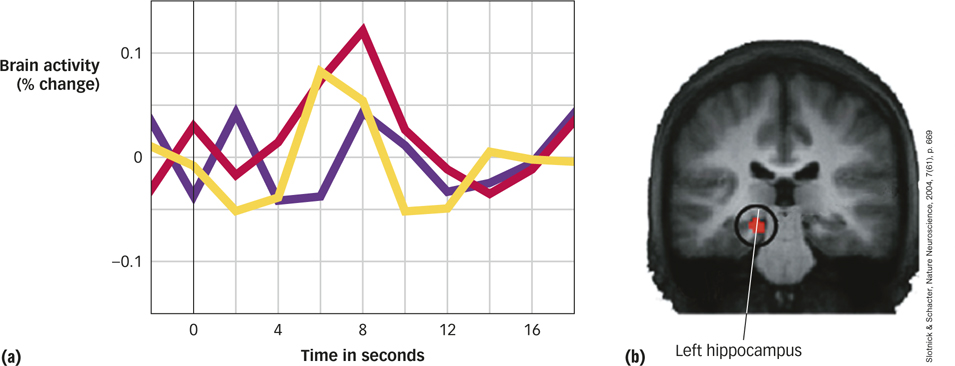
However, false recognition can be reduced (Schacter, Israel, & Racine, 1999). For example, recent evidence shows that when participants are given a choice between an object that they actually saw (e.g., a car) and a visually similar new object (a different car that looks like the one they saw), they almost always choose the car that they actually saw and thus avoid making a false recognition error (Guerin et al., 2012a, 2012b). When people experience a strong sense of familiarity about a person, object, or event but lack specific recollections, a potentially dangerous recipe for memory misattribution is in place, both in the laboratory and also in real-
198
5. Suggestibility
On October 4, 1992, a cargo plane crashed into an apartment building in a suburb of Amsterdam, killing 39 residents and all 4 members of the airline crew. The disaster dominated news in the Netherlands for days as people viewed footage of the crash scene and read about the catastrophe. Ten months later, Dutch psychologists asked university students: “Did you see the television film of the moment the plane hit the apartment building?” Fifty-
suggestibility
The tendency to incorporate misleading information from external sources into personal recollections.
How can eyewitnesses be misled?
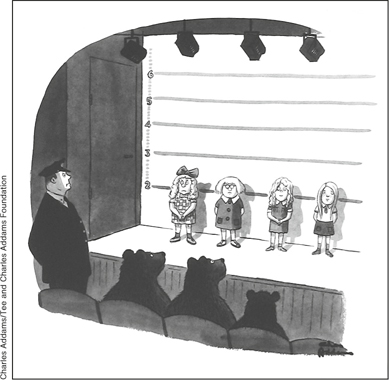
If misleading details can be implanted in people’s memories, is it also possible to suggest entire episodes that never occurred? The answer seems to be yes (Loftus, 1993, 2003). In one study, the research participant, a teenager named Chris, was asked by his older brother, Jim, to try to remember the time Chris had been lost in a shopping mall at age 5. He initially recalled nothing, but after several days, Chris produced a detailed recollection of the event. He recalled that he “felt so scared I would never see my family again” and remembered that a kindly old man wearing a flannel shirt found him crying (Loftus, 1993, p. 532). But according to Jim and other family members, Chris was never lost in a shopping mall. Of 24 participants in a larger study on implanted memories, approximately 25% falsely remembered being lost as a child in a shopping mall or in a similar public place (Loftus & Pickrell, 1995).
People develop false memories in response to suggestions for some of the same reasons memory misattribution occurs. We do not store all the details of our experiences in memory, making us vulnerable to accepting suggestions about what might have happened or should have happened. In addition, visual imagery plays an important role in constructing false memories (Goff & Roediger, 1998). Asking people to imagine an event like spilling punch all over the bride’s parents at a wedding increases the likelihood that they will develop a false memory of such a mishap (Hyman & Pentland, 1996).
199
Why can childhood memories be influenced by suggestion?
Suggestibility played an important role in a controversy that arose during the 1980s and 1990s concerning the accuracy of childhood memories that people recalled during psychotherapy. One highly publicized example involved a woman named Diana Halbrooks (Schacter, 1996). After a few months in psychotherapy, she began recalling disturbing incidents from her childhood—
How could this happen? A number of the techniques used by psychotherapists to try to pull up forgotten childhood memories are clearly suggestive (Poole et al., 1995). Specifically, research has shown that imagining past events and hypnosis can help create false memories (Garry et al., 1996; Hyman & Pentland, 1996; McConkey, Barnier, & Sheehan, 1998). More recent studies show that memories that people remember spontaneously on their own are corroborated by other people at about the same rate as the memories of individuals who never forgot their abuse, whereas memories recovered in response to suggestive therapeutic techniques are virtually never corroborated by others (McNally & Geraerts, 2009).

6. Bias
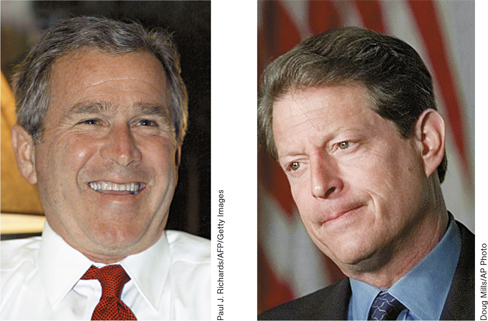
Doug Mills/AP Photo
How does your current outlook color your memory of a past event?
In 2000, the outcome of a very close presidential race between George W. Bush and Al Gore was decided by the Supreme Court 5 weeks after the election had taken place. The day after the election (when the result was still in doubt), supporters of Bush and Gore were asked to predict how happy they would be after the outcome of the election was determined (Wilson, Meyers, & Gilbert, 2003). These same respondents reported how happy they felt with the outcome on the day after Al Gore conceded. And 4 months later, the participants recalled how happy they had been right after the election was decided.
Bush supporters were understandably happy the day after the Supreme Court decision. However, their retrospective accounts overestimated how happy they were at the time. Conversely, Gore supporters were not pleased with the outcome. But when polled 4 months after the election was decided, Gore supporters underestimated how happy they actually were at the time of the result. In both groups, recollections of happiness were at odds with existing reports of their actual happiness at the time (Wilson et al., 2003).
These results illustrate the problem of bias, the distorting influences of present knowledge, beliefs, and feelings on recollection of previous experiences. Sometimes, what people remember from their pasts says less about what actually happened than about what they think, feel, or believe now. Researchers have also found that our current moods can bias our recall of past experiences (Bower, 1981; Buchanan, 2007; Eich, 1995). So, in addition to helping you recall actual sad memories (as you saw earlier in this chapter), a sad mood can also bias your recollections of experiences that may not have been so sad.
bias
The distorting influences of present knowledge, beliefs, and feelings on recollection of previous experiences.
200
Sometimes, we exaggerate differences between what we feel or believe now and what we felt or believed in the past. For example, most of us would like to believe that our romantic attachments grow stronger over time. In one study, dating couples were asked, once a year for 4 years, to assess the present quality of their relationships and to recall how they felt in past years (Sprecher, 1999). Couples who stayed together for the 4 years recalled that the strength of their love had increased since they last reported on it. Yet their actual ratings over time did not show any increases in love and attachment. Objectively, the couples did not love each other more today than yesterday. But they did from the subjective perspective of memory. People were remembering the past as they wanted it to be rather than the way it was.

7. Persistence
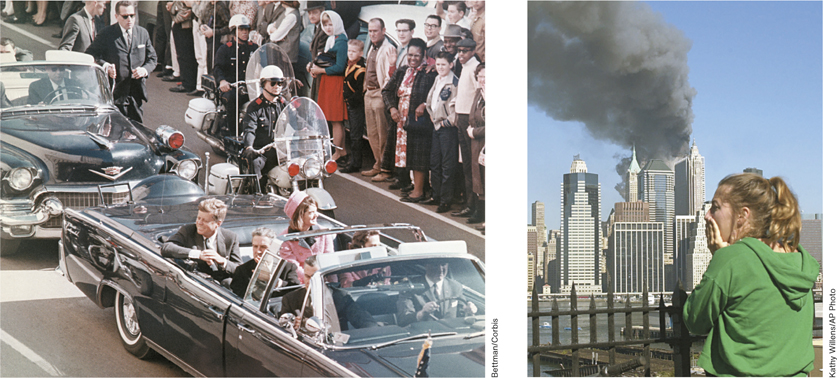
Kathy Willens/AP Photo
201
How does emotional trauma affect memory?

The artist Melinda Stickney-
Melinda Stickney-
persistence
The intrusive recollection of events that we wish we could forget.
Intrusive memories are undesirable consequences of emotional experiences because emotional experiences generally lead to more vivid and enduring recollections than nonemotional experiences do. One line of evidence comes from the study of flashbulb memories, which are detailed recollections of when and where we heard about shocking events (Brown & Kulik, 1977). For example, most Americans can recall exactly where they were and how they heard about the September 11, 2001, terrorist attacks on the World Trade Center and the Pentagon—
flashbulb memories
Detailed recollections of when and where we heard about shocking events.
Why do our brains succumb to persistence? A key player in the brain’s response to emotional events is the amygdala, shown in FIGURE 6.18. The amygdala influences hormonal systems that kick into high gear when we experience an arousing event; these stress-
In many cases, there are clear benefits to forming strong memories for highly emotional events, particularly those that are life-
Are the Seven Sins Vices or Virtues?
You may have concluded that evolution has burdened us with an extremely inefficient memory system that is so prone to error that it often jeopardizes our well-
Consider transience, for example. Although it might sound great to remember all the details of every incident in your life, the fact is that it’s helpful and sometimes important to forget information that isn’t current, like an old phone number. If we didn’t gradually forget information over time, our minds would be cluttered with details that we no longer need (Bjork, 2011; Bjork & Bjork, 1988). Memory, in essence, makes a bet that when we haven’t used information recently, we probably won’t need it in the future. We win this bet more often than we lose it, making transience an adaptive property of memory. But we are acutely aware of the losses—
How are we better off with imperfect memories?
Similarly, absentmindedness and blocking can be frustrating, but they are side effects of our memory’s usually successful attempt to sort through incoming information, preserving details that are worthy of attention and recall, and discarding those that are less worthy.
202
Memory misattribution and suggestibility both occur because we often fail to recall the details of exactly when and where we saw a face or learned a fact. Our memories carefully record such details only when we think they may be needed later, and most of the time, we are better off for it. Furthermore, we often use memories to anticipate possible future events. As discussed earlier, memory is flexible, allowing us to recombine elements of past experience in new ways so that we can mentally try out different versions of what might happen. But this very flexibility—
Although each of the seven sins can cause trouble in our lives, they have an adaptive side as well. You can think of the seven sins as costs we pay for benefits that allow memory to work as well as it does most of the time.
Other Voices: Early Memories
Early Memories

In this eloquent passage from his recent book about memory, Pieces of Light, psychologist Charles Fernyhough (2012, pp. 1–
“Can you remember?”
It starts with a question from my 7-
“Can you remember the first fish you ever caught?”
I stand straight and look out at the farm-
“I don’t know,” I reply. “I think so.”
What accounts for my uncertainty?
Try to recall your own earliest memory of a specific event from your life: How do you know when your recollection took place? How do you know that what you are remembering is the actual event? What kind of evidence would you require to be convinced that your memory is valid? Can you think of an experiment that might be conducted to provide that evidence?
One way to address this problem is to ask people about memories for events that have clearly definable dates, such as the birth of a younger sibling, the death of a loved one, or a family move. For example, one study found that individuals can recall events surrounding the birth of a sibling that occurred when they were about 2.4 years old (Eacott & Crawley, 1998).
Do you think that firm conclusions can be drawn from these kinds of studies? Isn’t it still possible that memories of these early events are based on family conversations that took place long after the events occurred? An adult or a child who remembers having ice cream in the hospital as a 3-
Charles Fernyhough, Pieces of Light: How the New Science of Memory Illuminates the Stories We Tell About Our Pasts. London: Profile Books Ltd., 2012/New York: Harper, 2013. Copyright © Charles Fernyhough, 2012. Reprinted by permission of the author, Profile Books Ltd., and Harper Collins Publishers.
203
SUMMARY QUIZ [6.5]
Question 6.13
| 1. | The rapid decline in memory, followed by more gradual forgetting, is reflected by |
- chunking.
- blocking.
- absentmindedness.
- transience.
d.
Question 6.14
| 2. | Eyewitness misidentification or false recognition is most likely a result of |
- memory misattribution.
- suggestibility.
- bias.
- retroactive interference.
a.
Question 6.15
| 3. | The fact that emotional arousal generally leads to enhanced memory is supported by |
- bias.
- persistence.
- proactive interference.
- source memory.
b.